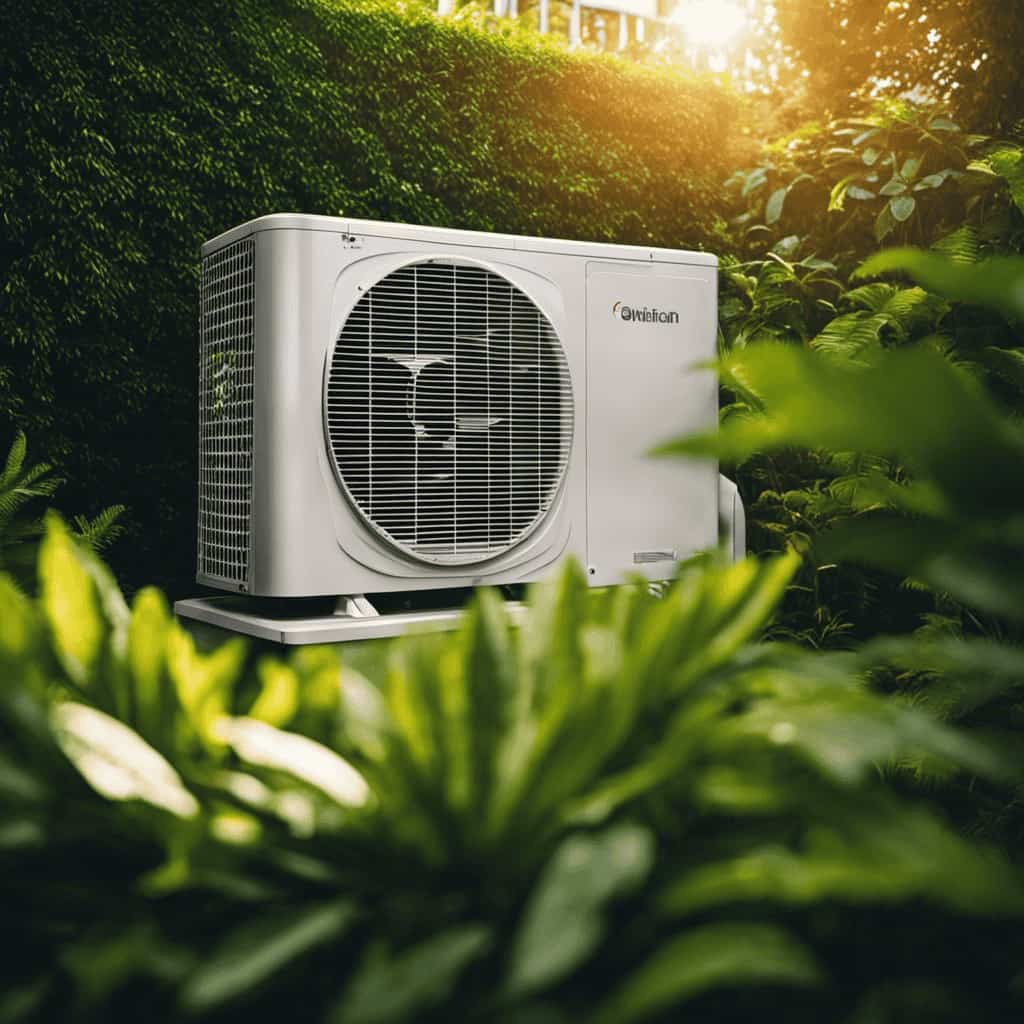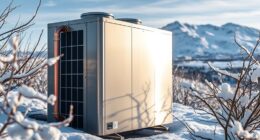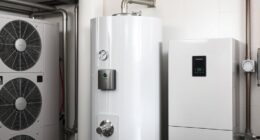Our purpose is to shed light on the yearly performance trends of AC heat pumps. It’s essential to grasp how your heat pump operates over the seasons to maximize energy savings and reduce costs. Were you aware that heating and cooling expenses account for 40% of your energy bills? In our discussion, we will explore the significance of seasonal performance, the method of its calculation, the elements influencing it, and the impact of weather conditions.
Get ready to make informed decisions about your AC heat pump’s performance!
Key Takeaways
- Seasonal performance of AC heat pumps is measured using SEER for cooling and HSPF for heating.
- SEER and HSPF reflect the efficiency of heat pumps by dividing the output by the energy input.
- Energy efficiency standards are important for evaluating the seasonal performance of AC heat pumps and promoting energy savings.
- Factors such as system size, design, installation quality, and climate affect the performance of heat pumps, and adhering to energy efficiency standards enhances overall efficiency.
What Is Seasonal Performance of AC Heat Pumps
We need to understand how the seasonal performance of AC heat pumps is measured in order to assess their energy savings and environmental impact.
Seasonal performance is a metric used to determine the efficiency of heat pumps over an entire heating or cooling season. It takes into account both the heating and cooling modes of operation.
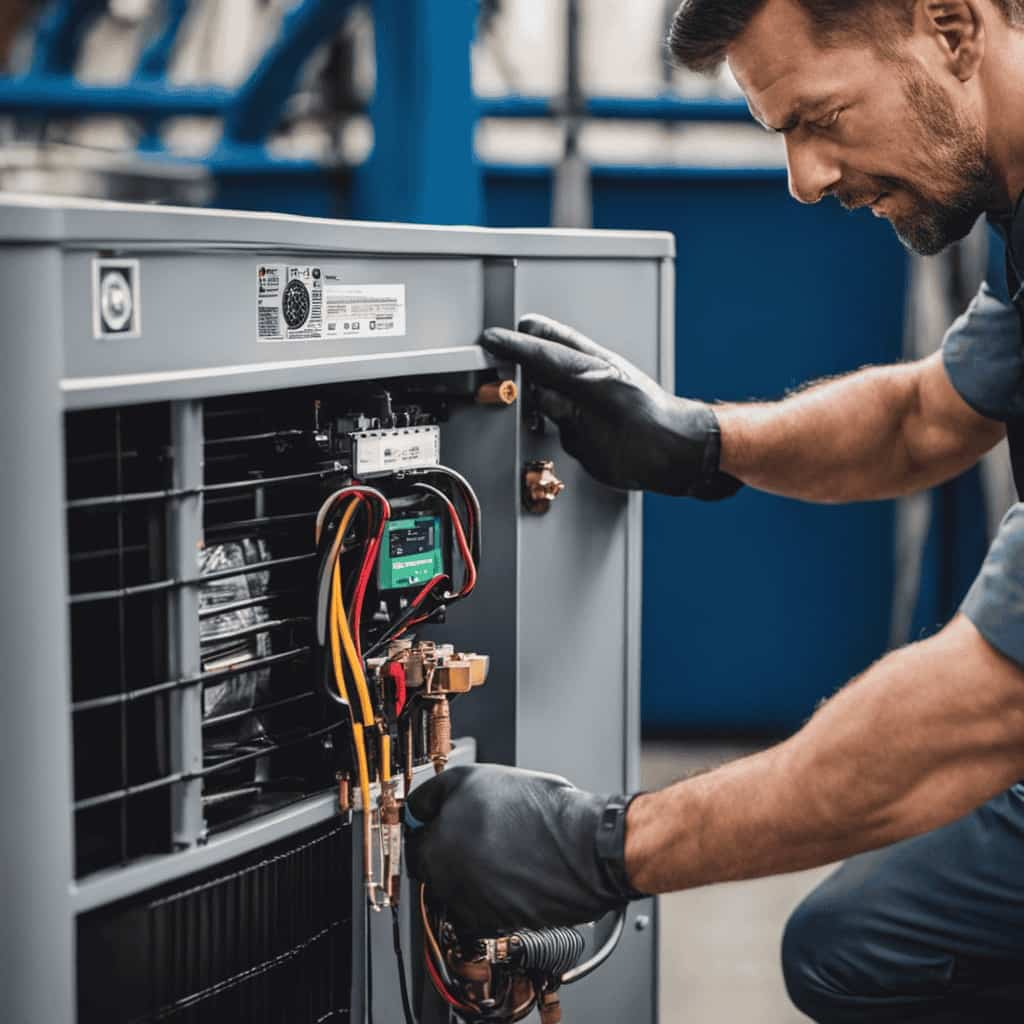
The measurement is expressed as the Seasonal Energy Efficiency Ratio (SEER) for cooling and the Heating Seasonal Performance Factor (HSPF) for heating. SEER represents the cooling output divided by the energy input, while HSPF measures the heating output divided by the energy input.
Understanding the Importance of Seasonal Performance
When it comes to AC heat pumps, understanding the importance of seasonal performance is crucial. Energy efficiency standards play a significant role in determining the overall performance of these systems.
Energy Efficiency Standards
Energy efficiency standards play a crucial role in evaluating the seasonal performance of AC heat pumps. These standards, set by energy efficiency regulations, ensure that AC heat pumps consume energy efficiently, reducing energy consumption and maximizing performance.
To assess the energy efficiency of AC heat pumps, an energy consumption analysis is conducted. This analysis measures the amount of energy consumed by the heat pump during different seasons, taking into account variations in temperature and workload.

The results of this analysis are used to determine the seasonal performance of AC heat pumps, allowing consumers to make informed decisions when selecting a unit. By adhering to energy efficiency standards, AC heat pumps not only provide optimal cooling and heating but also contribute to energy savings and a more sustainable future.
Environmental Impact Considerations
To mitigate environmental impact and understand the importance of seasonal performance, it’s essential to consider the efficiency and sustainability of AC heat pumps. Environmental regulations and the need for carbon footprint reduction have made it crucial for consumers and manufacturers to prioritize environmentally friendly options.
AC heat pumps play a significant role in reducing energy consumption and greenhouse gas emissions. By efficiently transferring heat from the outside to the inside during winter and vice versa during summer, these systems can significantly reduce energy usage compared to traditional heating and cooling methods. This translates into lower electricity consumption and, consequently, lower carbon emissions.
Furthermore, AC heat pumps can be designed with features that meet or exceed environmental regulations. By utilizing advanced technologies, such as variable-speed compressors and refrigerants with low global warming potential, these systems can further minimize their environmental impact.

Considering the environmental regulations and the urgent need to reduce our carbon footprint, investing in AC heat pumps with high seasonal performance isn’t only beneficial for individuals but also for the planet. These systems can help us achieve a more sustainable and energy-efficient future.
How Seasonal Energy Efficiency Ratio (Seer) Is Calculated
We calculate the Seasonal Energy Efficiency Ratio (SEER) by dividing the total cooling output of an air conditioning heat pump system by the total energy input over a specific season. This calculation provides an objective measure of the system’s energy efficiency and allows consumers to compare different models.
There are several SEER calculation methods used in the industry, including the bin method, the cooling degree-day method, and the energy balance method. Each method takes into account factors such as outdoor temperature, humidity levels, and system run time to determine the overall energy efficiency of the system.
Factors Affecting Seasonal Performance of Heat Pumps
Our understanding of the factors affecting the seasonal performance of heat pumps is crucial for optimizing their efficiency and effectiveness.
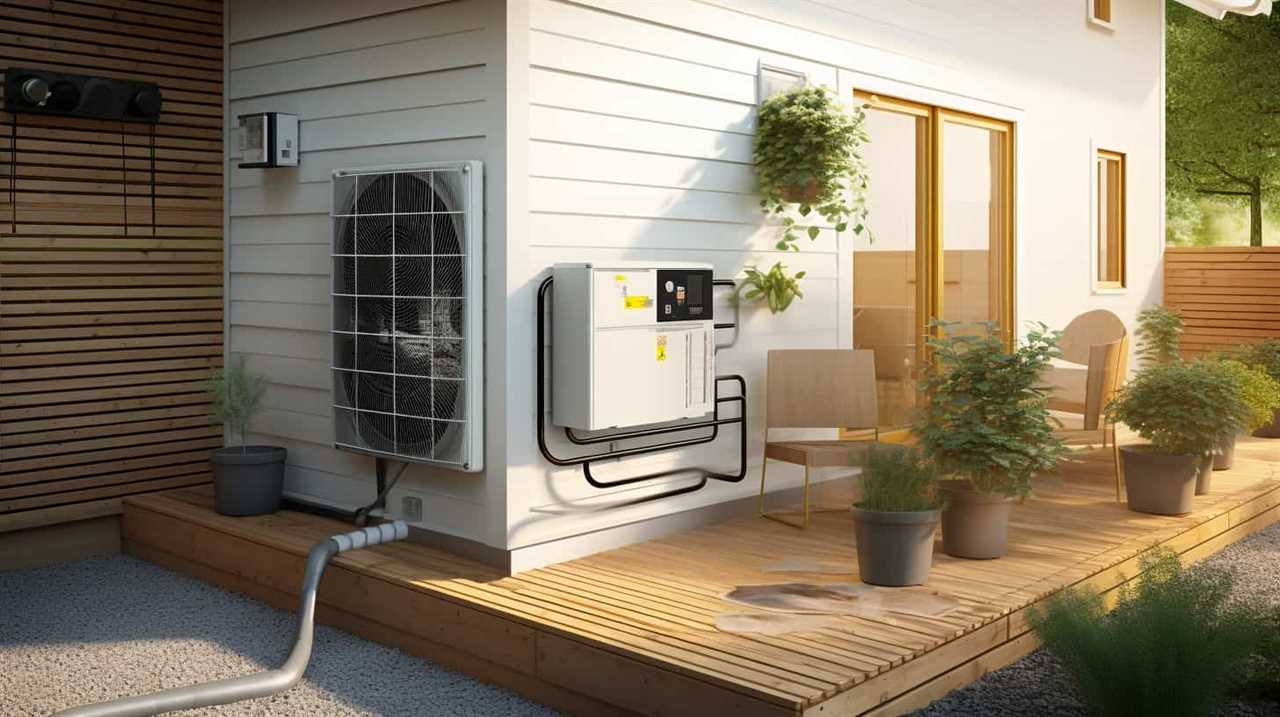
Several key factors influence the performance of heat pumps, including the size and design of the system, the quality of installation, and the maintenance practices employed.
Additionally, the climate in which the heat pump operates plays a significant role in its performance.
Energy efficiency standards have also been established to ensure that heat pumps meet minimum performance requirements.
These standards consider factors such as the heat pump’s cooling and heating capacities, its energy consumption, and its coefficient of performance.

By considering these factors and adhering to energy efficiency standards, we can enhance the overall performance and efficiency of heat pumps.
Now, let’s delve into the role of climate in seasonal performance.
The Role of Climate in Seasonal Performance
Considering the climate in which AC heat pumps operate is essential for understanding their seasonal performance. The role of climate, especially in the context of climate change and seasonal temperature fluctuations, can greatly impact the efficiency and effectiveness of AC heat pumps. Here are three key points to consider:
-
Climate Change: As global temperatures continue to rise, the demand for cooling systems like AC heat pumps increases. Heat pumps must be designed and optimized to perform efficiently in hotter climates to ensure maximum comfort and energy savings.
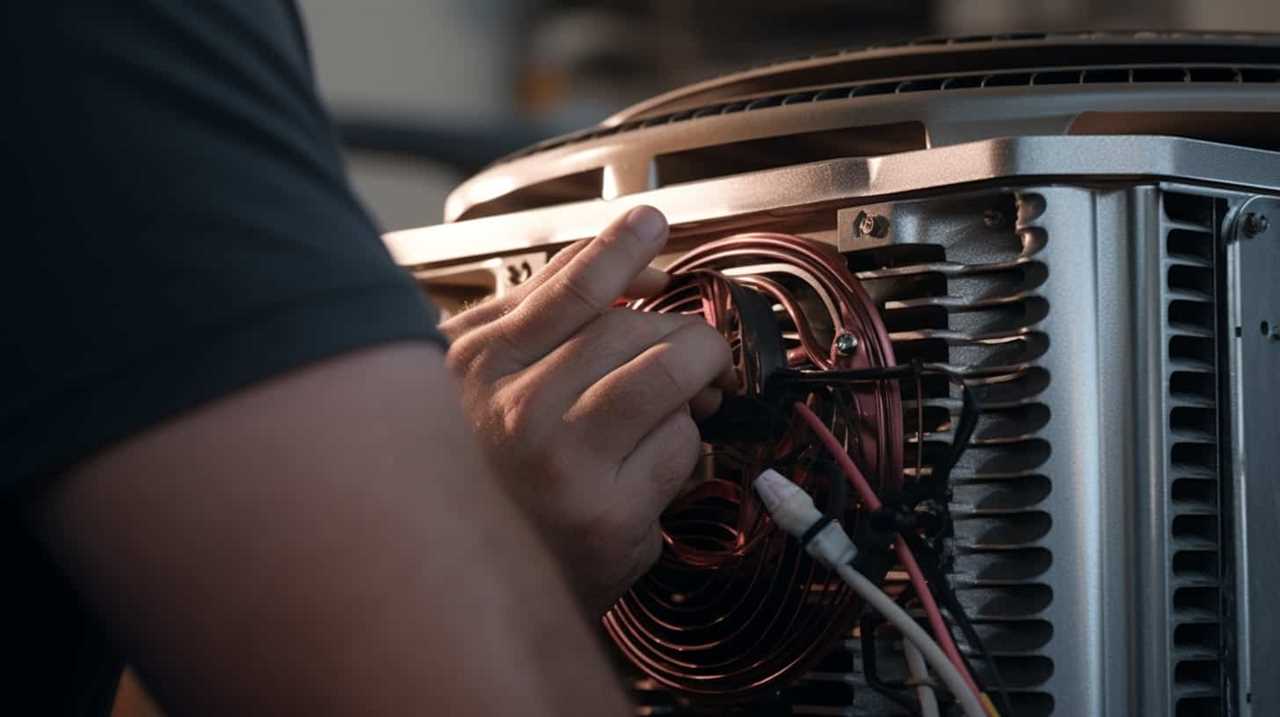
-
Seasonal Temperature Fluctuations: AC heat pumps are designed to provide both heating and cooling capabilities. However, their performance can vary depending on the temperature extremes experienced during different seasons. Understanding how the system responds to these fluctuations is crucial for optimal performance.
-
Regional Variations: Different regions experience varying climate patterns, such as humidity levels and temperature ranges. AC heat pumps need to be tailored to specific regional climates to deliver the best performance and energy efficiency.
Optimizing Seasonal Performance Through Regular Maintenance
Regular maintenance is crucial for optimizing the seasonal performance of AC heat pumps. By scheduling routine inspections and tune-ups, homeowners can ensure that their units are running efficiently and effectively.
This not only improves energy efficiency and reduces utility costs but also extends the lifespan of the system, resulting in long-term cost-saving benefits.

Importance of Maintenance
Maintaining AC heat pumps is crucial for optimizing their seasonal performance. Regular upkeep not only ensures that the system operates efficiently, but also provides long-term cost savings. Here are three reasons why maintenance is important:
-
Improved Energy Efficiency: Regular maintenance helps keep the heat pump running at its peak efficiency, reducing energy consumption and lowering utility bills.
-
Extended Lifespan: Proper maintenance prolongs the lifespan of the AC heat pump, saving homeowners from the expensive cost of premature replacement.
-
Enhanced Indoor Comfort: Well-maintained heat pumps deliver consistent and reliable heating and cooling, creating a comfortable living environment for homeowners.
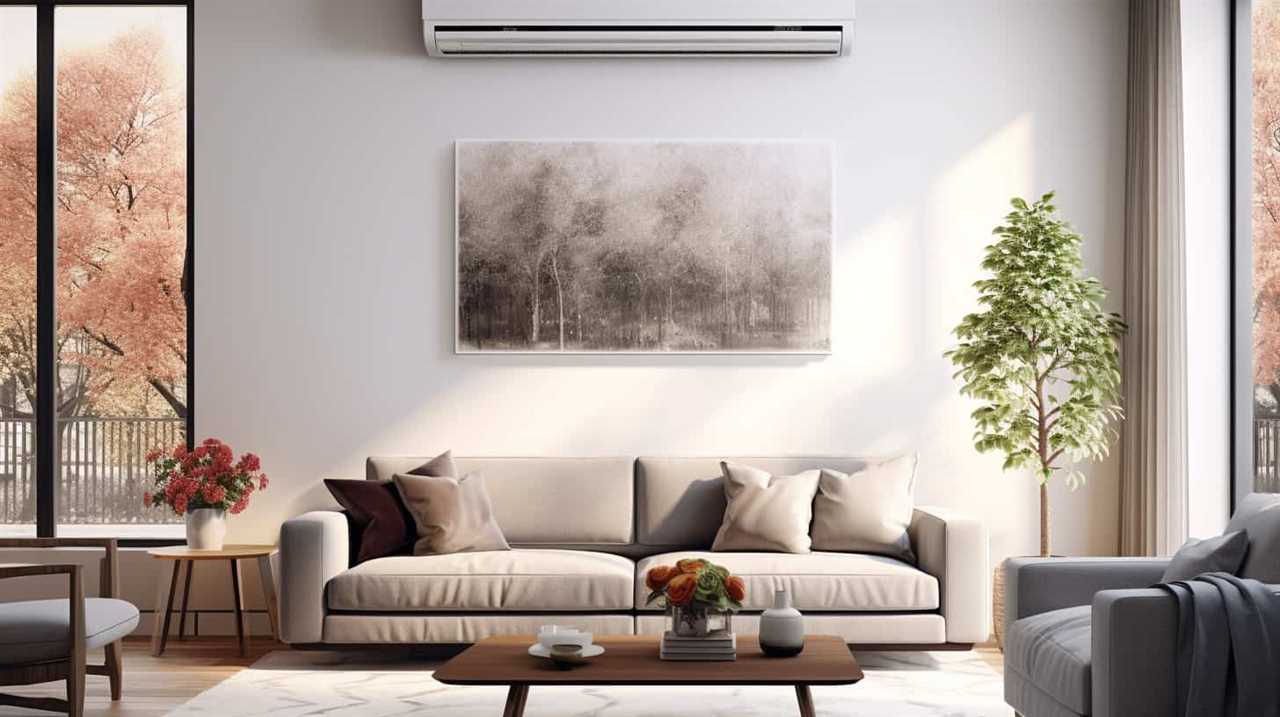
By investing in routine maintenance, homeowners can enjoy the benefits of improved energy efficiency, longer equipment lifespan, and enhanced indoor comfort.
It’s essential to prioritize maintenance to optimize the seasonal performance of AC heat pumps and achieve long-term cost savings.
Energy Efficiency Tips
To maximize the seasonal performance of our AC heat pumps, we should regularly clean or replace air filters and ensure proper airflow through the system. This is crucial for energy efficiency and reducing our carbon footprint. By maintaining clean air filters, we allow the heat pump to operate at its optimal level, preventing dust and debris from obstructing airflow and reducing performance. Additionally, regular maintenance helps identify any potential issues early on, preventing costly repairs and ensuring smooth operation throughout the season. Here are some energy-saving techniques to optimize the seasonal performance of our AC heat pumps:
| Energy Efficiency Tips | Benefits |
|---|---|
| Schedule annual professional maintenance | Increases system efficiency and longevity |
| Seal air leaks in ductwork | Reduces energy loss and improves airflow |
| Use programmable thermostats | Allows for customized temperature settings and energy savings |
| Install ceiling fans | Enhances air circulation and reduces reliance on AC |
| Use natural shading and insulation | Reduces heat gain and loss, improving energy efficiency |
Cost-Saving Benefits
By performing routine maintenance and optimizing seasonal performance, we can enjoy cost-saving benefits for our AC heat pumps. Here are three energy-saving techniques and cost-effective solutions to help you achieve optimal performance and reduce expenses:

-
Regular Filter Cleaning: Clean or replace your AC heat pump’s filters every few months to ensure proper airflow and efficiency. Clogged filters can restrict airflow, causing your system to work harder and consume more energy.
-
Annual Professional Inspection: Schedule an annual inspection by a qualified technician to identify and fix any issues before they become major problems. This proactive approach can improve efficiency and prevent costly repairs down the line.
-
Proper Temperature Settings: Set your thermostat to a comfortable yet energy-efficient temperature. Lowering the temperature by a few degrees during winter and raising it during summer can significantly reduce energy consumption.
By implementing these energy-saving techniques and cost-effective solutions, you can optimize the seasonal performance of your AC heat pump and save money on energy bills.

Now, let’s dive into comparing the seasonal performance of different heat pump models.
Comparing Seasonal Performance of Different Heat Pump Models
We compare the seasonal performance of different heat pump models. When selecting a heat pump, it is important to consider its energy efficiency and performance. By comparing various models, you can make an informed decision that maximizes energy savings and reduces utility costs. Below is a performance comparison table for five popular heat pump models:
| Heat Pump Model | Seasonal Energy Efficiency Ratio (SEER) | Heating Seasonal Performance Factor (HSPF) |
|---|---|---|
| Model A | 18.5 | 9.8 |
| Model B | 20.2 | 10.3 |
| Model C | 17.8 | 9.4 |
| Model D | 19.6 | 10.1 |
| Model E | 18.9 | 9.7 |
As seen in the table, higher SEER and HSPF values indicate better energy efficiency and performance. Choosing a heat pump with higher ratings can lead to significant energy savings over time. In the next section, we will explore the impact of seasonal performance on energy savings.
The Impact of Seasonal Performance on Energy Savings
Higher seasonal performance of AC heat pumps results in significant energy savings. The impact of weather and long-term savings can’t be overlooked when considering the benefits of investing in a high-performance heat pump.

Here are three key reasons why higher seasonal performance leads to energy savings:
-
Efficient operation in extreme weather conditions: Heat pumps with higher seasonal performance are designed to perform optimally even in extreme weather conditions, such as extremely hot summers or freezing winters. This ensures that the AC heat pump operates efficiently, consuming less energy to maintain a comfortable indoor temperature.
-
Reduced energy consumption: AC heat pumps with higher seasonal performance have advanced features and technologies that allow them to operate with greater efficiency, resulting in lower energy consumption. This translates to reduced energy bills and long-term savings for homeowners.
-
Energy-saving modes and smart features: High-performance heat pumps often come equipped with energy-saving modes and smart features that optimize energy usage. These features can include programmable thermostats, occupancy sensors, and adaptive controls, which help to further reduce energy consumption and increase overall energy savings.

Investing in an AC heat pump with higher seasonal performance not only ensures comfort in all weather conditions but also brings significant energy savings in the long run.
Seasonal Performance Considerations for Different Regions
When considering the seasonal performance of AC heat pumps, it’s important to take into account the impact of climate on efficiency and the variations in energy costs across different regions.
The efficiency of heat pumps can be affected by factors such as temperature extremes and humidity levels, which vary significantly from one region to another.
Additionally, energy costs can vary based on factors such as the availability of renewable energy sources and the overall demand for electricity in a particular region.

Understanding these considerations is crucial for optimizing the performance and cost-effectiveness of AC heat pumps in different regions.
Climate Impact on Efficiency
Our understanding of how climate impacts the efficiency of AC heat pumps in different regions is crucial for optimizing seasonal performance. The efficiency of AC heat pumps can vary significantly based on the climate and weather conditions of a particular region.
Here are three key factors to consider:
-
Temperature range: AC heat pumps are designed to work efficiently within a specific temperature range. Extreme cold or hot climates can reduce their efficiency and performance.
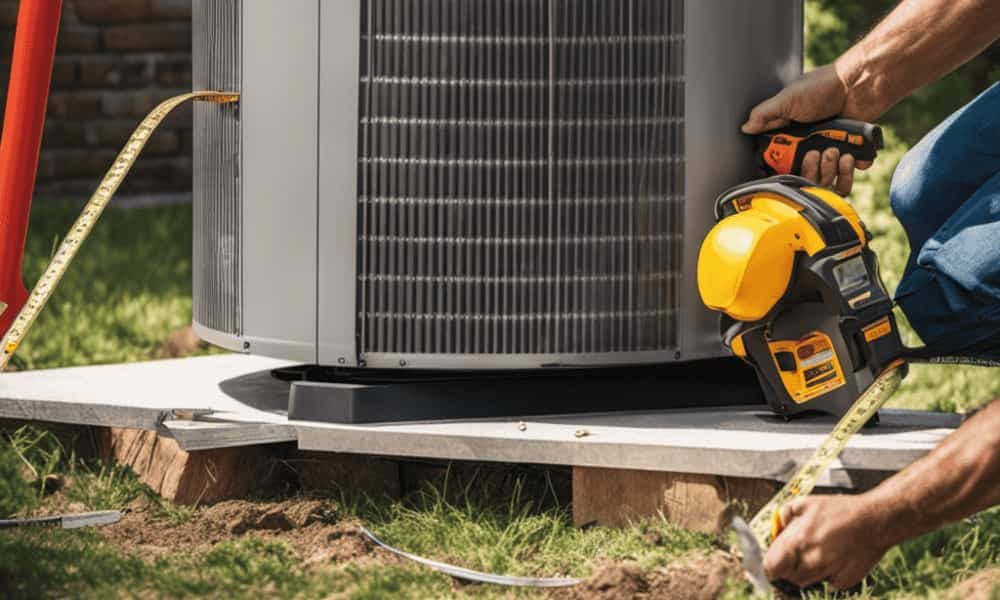
-
Humidity levels: High humidity can make the cooling process less effective, requiring the AC heat pump to work harder and consume more energy.
-
Seasonal variations: AC heat pumps may have different efficiency ratings for cooling and heating modes. Understanding the seasonal changes and adjusting the settings accordingly can help optimize their performance.
Energy Cost Variations
We should also consider the impact of energy cost variations when analyzing the seasonal performance of AC heat pumps in different regions. Energy costs can vary greatly depending on the region, and this can have a significant impact on consumer bills. It’s important to take into account these cost variations when evaluating the efficiency and effectiveness of energy saving techniques for AC heat pumps.
By understanding the energy cost variations, we can better assess the overall cost-effectiveness of using AC heat pumps in different regions. This information can help consumers make informed decisions about their heating and cooling systems and optimize their energy usage to reduce their bills.
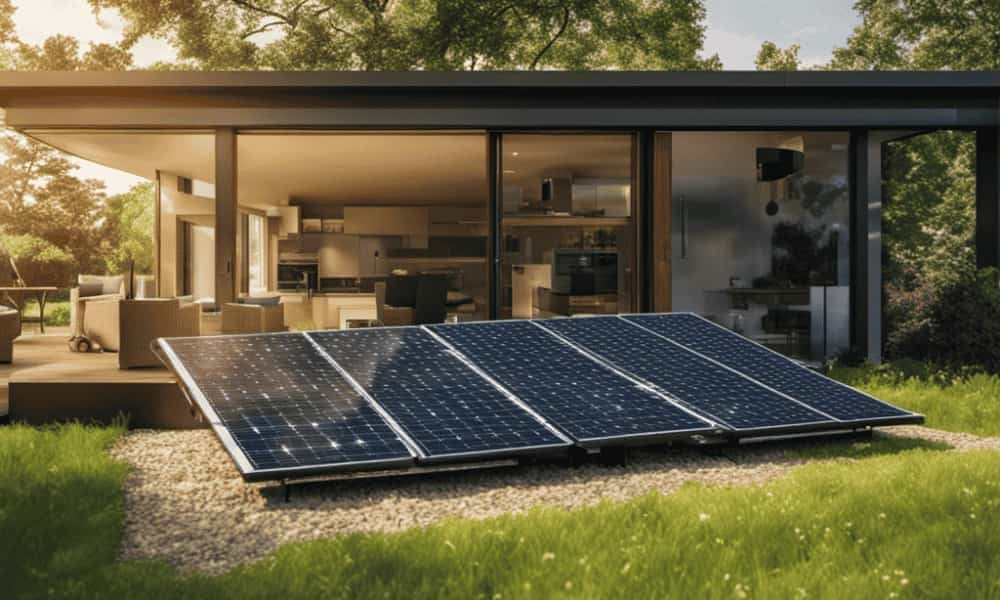
In the next section, we’ll delve into the comparison between seasonal performance and instantaneous efficiency of AC heat pumps.
Seasonal Performance Vs. Instantaneous Efficiency
Seasonal performance of AC heat pumps differs from instantaneous efficiency. While instantaneous efficiency measures the efficiency of a heat pump at a specific moment in time, seasonal performance takes into account the heat pump’s performance over an entire heating or cooling season. Here are three key differences between seasonal performance and instantaneous efficiency:
-
Seasonal performance measurement: Seasonal performance is measured using metrics such as Seasonal Energy Efficiency Ratio (SEER) and Heating Seasonal Performance Factor (HSPF), which provide a more comprehensive assessment of a heat pump’s efficiency throughout the year.
-
Real world efficiency assessment: Instantaneous efficiency is typically measured under ideal laboratory conditions, whereas seasonal performance takes into account real-world factors such as climate variations, occupancy patterns, and equipment maintenance.
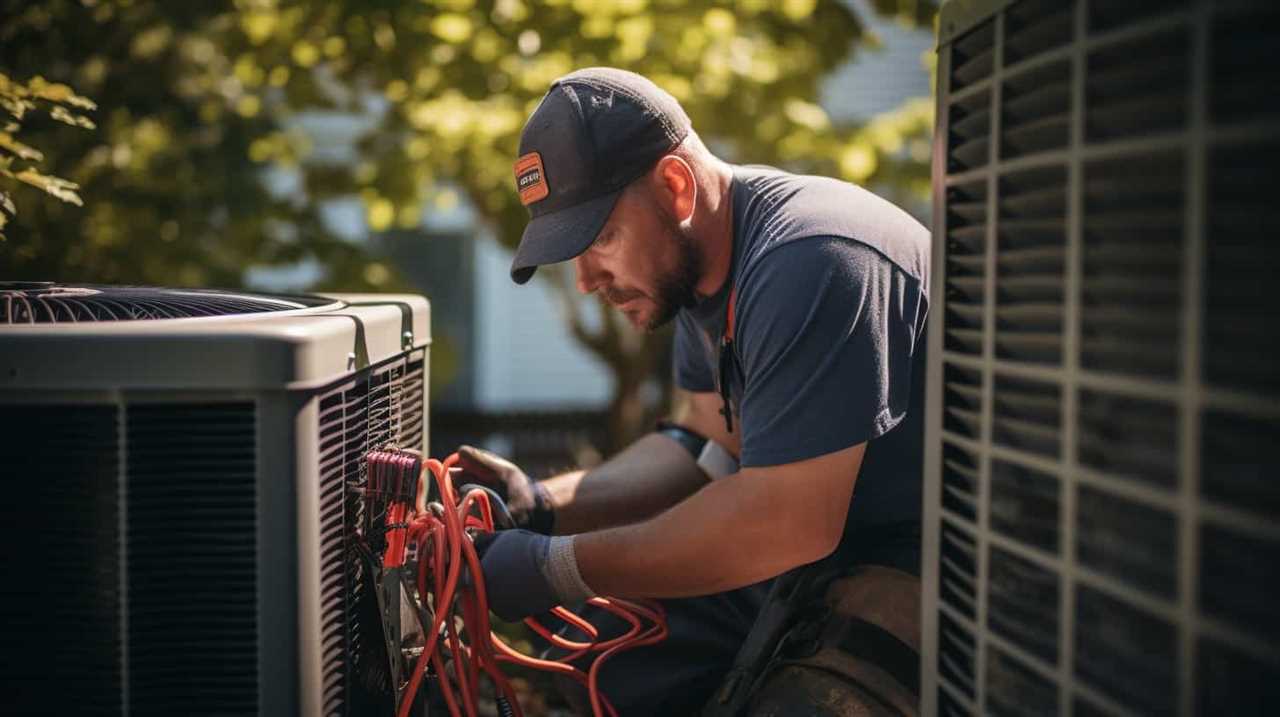
-
Reflecting overall performance: Seasonal performance provides a more accurate representation of a heat pump’s overall performance, as it considers the varying efficiency levels during different operating conditions and weather conditions.
Understanding the difference between seasonal performance and instantaneous efficiency is crucial in evaluating the long-term energy efficiency and cost savings of AC heat pumps.
Transitioning into the subsequent section on future trends, it’s important to explore ways to improve the seasonal performance of AC heat pumps even further.
Future Trends in Improving Seasonal Performance of AC Heat Pumps
Let’s explore the future trends in improving the seasonal performance of AC heat pumps.

As energy efficiency becomes increasingly important, manufacturers are focused on developing technologies that maximize energy savings.
One of the future trends in improving seasonal performance is the integration of smart controls and machine learning algorithms. These advancements allow heat pumps to adapt and optimize their operations based on real-time weather conditions and user preferences.
By continuously analyzing data and making adjustments, AC heat pumps can achieve higher energy efficiency and reduce overall energy consumption.
Another trend is the use of advanced refrigerants that have lower global warming potential and higher thermal efficiency. These refrigerants not only improve the environmental impact of heat pumps but also contribute to increased energy savings.

With these future trends, AC heat pumps are poised to become even more efficient and environmentally friendly, providing significant benefits to both consumers and the planet.
Frequently Asked Questions
What Is the Difference Between Seasonal Performance and Instantaneous Efficiency of AC Heat Pumps?
The difference between seasonal performance and instantaneous efficiency of AC heat pumps lies in their measurement over time versus a single moment. Insulation plays a crucial role in improving efficiency, impacting both COP and EER.
How Does Regular Maintenance Affect the Seasonal Performance of AC Heat Pumps?
Regular maintenance, like fine-tuning an instrument before a concert, keeps our AC heat pumps in top shape. It ensures optimal energy efficiency, enhancing the seasonal performance and helping us keep our cool.
What Are the Key Factors to Consider When Comparing the Seasonal Performance of Different Heat Pump Models?
When comparing the seasonal performance of different heat pump models, key factors to consider include energy efficiency, SEER ratings, HSPF ratings, and the overall cost of operation. Evaluating these factors helps determine the most efficient and cost-effective option.

How Does Climate ImpACt the Seasonal Performance of AC Heat Pumps?
Climate impact plays a crucial role in the seasonal performance of AC heat pumps. It directly influences energy consumption, as heat pumps work harder in extreme temperatures. Understanding these effects helps optimize efficiency and reduce costs.
What Are Some Future Trends or Technologies That Could Improve the Seasonal Performance of AC Heat Pumps?
Smart technology and renewable energy integration are future trends that could improve the seasonal performance of AC heat pumps. They optimize energy consumption, enhance system efficiency, and contribute to a sustainable and eco-friendly operation.
Conclusion
In conclusion, understanding the seasonal performance of AC heat pumps is crucial for maximizing energy efficiency and savings.
Factors such as climate and region play a significant role in determining the effectiveness of these systems.

By considering the seasonal energy efficiency ratio (SEER) and making informed decisions based on performance considerations, consumers can optimize their energy usage.
As future trends focus on improving seasonal performance, it’s essential to stay updated on advancements in AC heat pump technology to ensure maximum efficiency.



